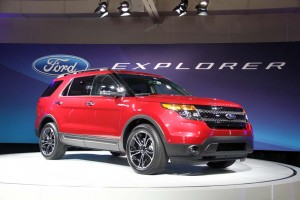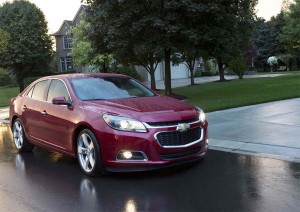
The shift to car-based crossovers -- such as the latest version of the Ford Explorer - has helped drive the ongoing boom of utility vehicles.
With the U.S. auto industry in full recovery mode, manufacturers are struggling to keep up with demand of some of their most popular sport-utility vehicles and crossovers which, for the first time, are now outselling conventional sedans, according to a new study.
Utility vehicles, whether traditional, truck-like SUVs, or more modern, car-like crossovers, accounted for 36.5% of the overall American market during the first five months of 2014, compared with 35.4% for sedans, long the dominant body style, according to an analysis of new vehicle registrations by IHS Automotive. A year ago, sedans outsold “utes” 36.6% to 33.9%.
“These vehicles offer the combination of appealing features associated with both cars and light trucks, including a higher seating position, higher ground clearance, softer ride, more interior space, optional four-wheel or all-wheel drive, and towing capacity, among others,” said HIS analyst Tom Libby.
Meanwhile, what the industry refers to as trucks — including all utility vehicles, vans and pickups – has an even more solid hold on the market, accounting for 53.2% of total U.S. new vehicle sales.
(Click Here to find out which are the safest used cars, trucks and crossovers for your teen driver.)
The growing demand for utes has been increasingly apparent since the mid-1980s, when the first truly highly-volume models, such as the Jeep Wrangler and Grand Cherokee, and Ford Explorer, first came to market.
Initially slow to respond, Japanese makers began to roll out their own mainstream SUVs by the mid-1990s, but they also shifted the rules with models like the Toyota RAV-4 and Honda CR-V, which might have looked like conventional sport-utility vehicles but were actually based on the same platforms as some of their more popular passenger cars. These so-called “soft-roaders” sacrificed some of their off-road capabilities but picked up better on-road manners, as well as improved fuel economy.
(Surge in diesel sales outpaces overall U.S. auto recovery – even as hybrid demand declines. Click Here for the latest.)
By a decade ago, conventional SUV sales were peaking at around 3 million a year and have generally been on a decline ever since. CUV sales, however, have continued to grow and are now well over the old SUV peak, with little sign that they might taper off anytime soon. Quite the contrary.
Over the last few years, a growing number of traditional, truck-based utility vehicles have migrated to car-like crossover platforms, among the most notable being the Ford Explorer and Escape models, as well as the Nissan Pathfinder. In fact, there are only a handful of traditional SUV models still available.
Meanwhile, the range of crossover-style offerings has rapidly grown. In fact, one of the market’s fastest-growing segments is comprised of luxury compact CUVs, such as the new Lexus NX and Lincoln MKC. Even Jaguar is expected to enter the market over the next several years.
Whatever the reason, the overall ute segment has been growing rapidly, increasing its share of the American market from 31.4% in 2009 to the current 36.5%. Sedans, on the other hand, declined from 36.3% to 35.4% over the same period. Hatchbacks, coupes and convertibles have also lost ground.
While utility vehicles may be on the upswing, vans have declined sharply over the past five years, from 5.0 to just 3.6%, noted IHS. The biggest drop has been in the minivan segment. The slump has been so severe that a number of makers have dropped out entirely, and even Chrysler, credited with inventing the modern minivan, will eliminate one of its two remaining models soon, tossing aside the Chrysler Town & Country.
On the other hand, some analysts believe commercial vans could gain ground with the introduction of new offerings from Chrysler, General Motors and Ford, among others.
Pickups have also lost ground, the IHS study pointed out, slipping from 14.1% to 13.1% over the past half-decade. Much of that is the result of a shift by many “urban cowboys” away from the trucks that, for awhile, had become common in as unlikely a place as Greenwich, Connecticut. But as the economy recovers, so have pickup sales, much of that driven by demand from more traditional users who need to replace aging work trucks.
(Tesla plans to go mainstream with $35,000 Model E battery-electric vehicle. Click Here for more.)
For the short- to mid-term analysts stress, utility vehicles are expected to continue their ascendancy.
“Between product introduction activity and expected decline in fuel prices, market conditions in the short-term forecast point to continued momentum within the SUV/CUV segments, said Chris Hopson, manager of North American light vehicle sales forecasting for IHS Automotive.
That said, the segment may not grow indefinitely. “Longer term,” cautioned Hopson, “concerns over fuel efficiency standards and rising oil prices are expected to pressure light truck sales.”

